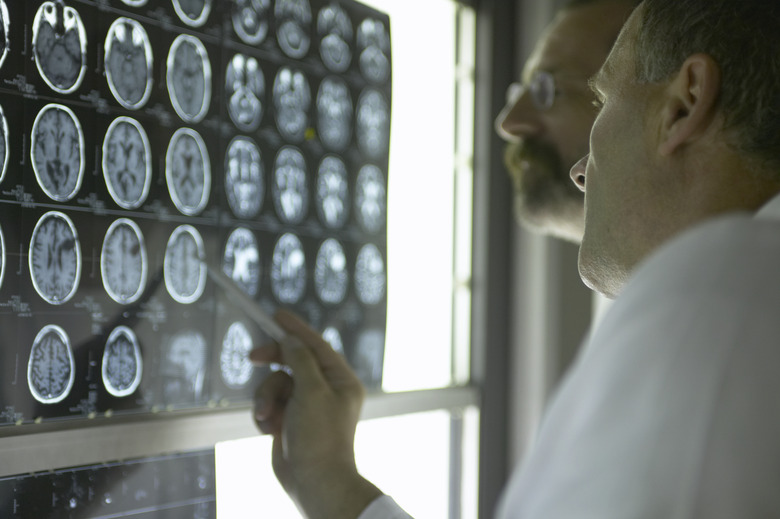What Are The Differences Between A CNS & A PNS?
The human nervous system is a complicated system of connecting neurons and associated cells. The nervous system allows us to think, breathe and feel. Scientists categorize the nervous system into two main parts: the central nervous system (CNS) and the peripheral nervous system (PNS). These parts of the nervous system differ in their structures and physiological functions.
Basic Structures
Basic Structures
The CNS consists of the brain and spinal cord, while the PNS includes all other nervous system tissue. All sensory receptors, sensory neurons and motor neurons are part of the PNS. The bones of the skull and spinal vertebrae encase all CNS neurons. Neurons in the PNS are not encased in bone; rather, they travel through or lie on top of muscle, organ and skin tissue. Groups of neurons form in both the CNS and the PNS. In the CNS, a group of neurons is called a nucleus. In the PNS, a group of cell bodies is known as a ganglion, while a bundle of neuron tracts is called a nerve.
Function
Function
The primary purpose of the CNS is to organize and analyze information. Nervous system impulses run to and from the brain via the spinal cord. Different areas of the brain process sensory and motor information, allowing us to observe and react to our environment. The central purpose of the PNS is to follow the commands of the CNS. Neurons in the PNS gather sensory information from the environment and relay it to the CNS. After the CNS processes the information, the PNS responds to its commands by changing motor output.
Divisions
Divisions
The brain and spinal cord are broken down by their general purposes. For example, the brain consists of the cerebrum, diencephalon, midbrain and hindbrain. Each brain region performs a specific set of tasks. The PNS is divided into the somatic nervous system and the autonomic nervous system. The somatic nervous system consists of consciously controlled nerves that receive sensory information and execute motor commands. The autonomic nervous system operates without conscious commands from the brain. It monitors heart rate, digestive activity, breathing, salivation and sexual arousal.
Considerations
Considerations
Experts divide the nervous system into the CNS and PNS to classify its important functions. However, both parts of the nervous system work in tandem and are essential to life. Without the PNS, the CNS would not have any sensory input to process, making it impossible to react to the environment. Likewise, the PNS relies upon the CNS to coordinate information from different body parts and make decisions about how you should react in a given situation. These two parts of the nervous system work together in synchrony to create our conscious experience of everyday life.
References
Cite This Article
MLA
Adams, Lawrence. "What Are The Differences Between A CNS & A PNS?" sciencing.com, https://www.sciencing.com/differences-between-cns-pns-8223236/. 13 March 2018.
APA
Adams, Lawrence. (2018, March 13). What Are The Differences Between A CNS & A PNS?. sciencing.com. Retrieved from https://www.sciencing.com/differences-between-cns-pns-8223236/
Chicago
Adams, Lawrence. What Are The Differences Between A CNS & A PNS? last modified March 24, 2022. https://www.sciencing.com/differences-between-cns-pns-8223236/
